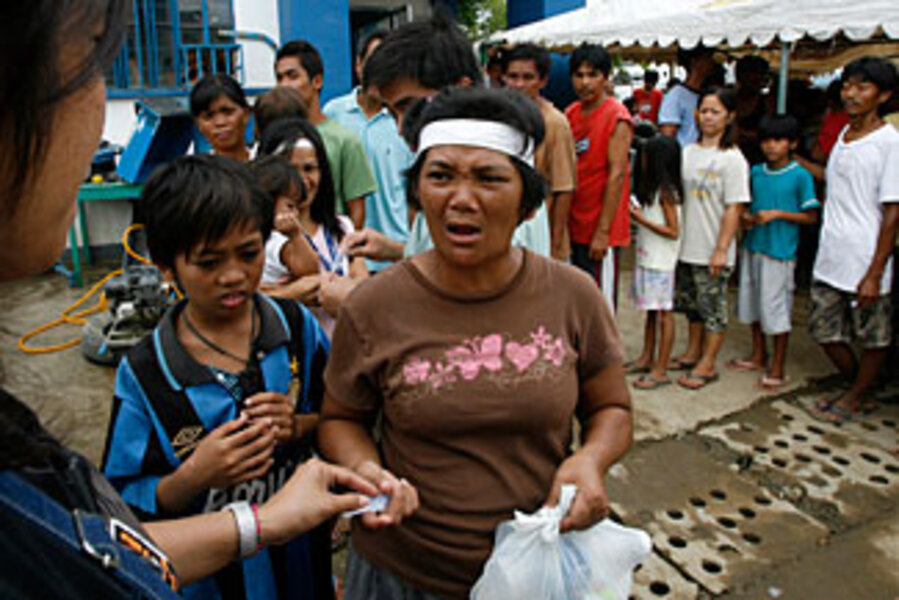Blame game intensifies over Philippines typhoon response
Loading...
| Bangkok, Thailand
The floodwaters around the deluged Philippine capital Manila have yet to fully subside after the onslaught of two successive tropical storms. But the blame game over the response to the crisis, and the nation's lack of preparedness, is rippling outward.
In total, more than 700 people have died and at least 6 million have been displaced, first by tropical storm Ketsana, which reached Manila on Sept. 26, and then by typhoon Parma, which circled for a week over northern Luzon island and inundated communities, roads, and fields in the country's breadbasket. Losses to agriculture are estimated at $400 million.
On Wednesday, President Gloria Arroyo described the Philippines as a victim of climate change and said she would seek as much as $1 billion in foreign aid to pay for rehabilitation. A donor conference is expected by early December. The UN has launched a separate $74 million relief appeal.
But questions have been raised about the extent to which hillside deforestation, watershed urbanization, and the growth of riverside slums had undermined Manila's disaster management. Critics say the politicians pleading for aid have ignored repeated warnings of the capital's vulnerability to tropical storms.
The result may be less a parable of climate change – some experts say extreme weather events are increasing as a result of global warming – than the failings of successive elected governments to heed the advice of urban planners.
"A country that doesn't protect its people before disasters has no business panhandling after," wrote Juan Mercado, a columnist in the Philippine Inquirer.
The row may have political consequences as the Philippines prepares to elect a new president next May. Ms. Arroyo, who took office in 2001, isn't eligible to run again. Her defense secretary, Gilbert Teodoro, who has declared his candidacy, chairs a disaster coordinating council that has been criticized over the sluggish flow of aid to storm victims, as well as the continued inundation of some communities.
In a national poll taken before the storms struck and released Wednesday, Mr. Teodoro trailed far behind Sen. Benigno Aquino, who was the choice of 60 percent of respondents. Only 4 percent of respondents named him as their preferred choice.
Mr. Aquino is the largely untested son of popular former President Corazon Aquino, who died in July and is credited for steering the nation to democracy after the fall of dictator Ferdinand Marcos in 1986. The second placed candidate, Sen. Manuel Villar, polled 37 percent in the survey. Former President Joseph Estrada, who was ousted in 2001 and put on trial for corruption, came third.
Teodoro's prominence in the relief operations may boost his poll numbers if voters feel gratitude for what aid did come their way, says Steven Rood, the country director for the Asia Foundation, a US nonprofit. It could go the other way, though, if the cleanup effort falters and victims blame the administration.
What this means for mitigation efforts against future storms is uncertain. "As so often in the Philippines, it gets ground down in political machinations about who takes the credit and who takes the blame," he says.
In the Philippine Congress, lawmakers have railed against government agencies in and around metro Manila, a conurbation of nearly 12 million people, around one-third of whom live in slums. An opposition senator said the 17 mayors of Manila's component cities should be suspended for six months. Another vowed to sue upstream dam managers for releasing excess water into city waterways that burst their banks.
Risk factor: unchecked growth
Researchers have identified several factors that put the capital at risk of repeated flooding. Among them is the unchecked growth of shantytowns along waterways into which tons of solid waste is dumped daily. But plans to resettle slum dwellers, mostly migrants from the countryside, have proven politically unpalatable. Zoning laws are also widely flouted in city districts and outlying watershed areas.
The economic cost of the storms is still being calculated. Government officials have played down the impact on national economic growth, which is forecast for this year at between 0.8 percent and 1.8 percent, and said higher remittances from overseas workers would offset the losses.
Congress has approved $260 million in typhoon relief funds, in addition to the foreign funding sought for what may prove to be an arduous recovery. Small businesses on Luzon island have been hit hard by the floods, which destroyed roads and bridges and washed away corn and rice crops.
On the southern island of Mindanao, where US troops are supporting Philippine security forces battling Islamic militants, monsoon rains in July uprooted tens of thousands of families. Government officials have appealed to donors not to overlook their plight or those of families displaced last year by fighting between Philippine troops and rebels after a peace deal collapsed.
Corruption may deter foreign aid
But the Philippines's poor record on combating corruption may deter foreign donors. Some are opting to donate to private charities, including the Red Cross. Overseas Philippine workers, on whose remittances many families depend, have also donated to private agencies, rather than give money to the government, according to PSA Group, a political risk consultancy in Manila.
The UN's appeal has received only $19 million, the UN's humanitarian chief John Holmes said Tuesday. He blamed the shortfall on straitened donor economies and a plethora of global humanitarian crises.
Mr. Rood says concerns over aid transparency may be premature as the lead government agency on relief efforts, the Department of Social Welfare and Development, is regarded as fairly professional. But the process would need to be watched closely to ensure that aid is properly spent.
"In the relief part there isn't a lot of worry about this. It's in the reconstruction when huge amounts of capital need to be committed," he says.





